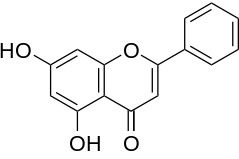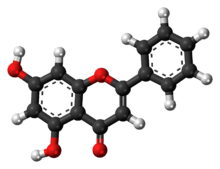Chrysin
 | |
 | |
| Names | |
|---|---|
| IUPAC name
5,7-Dihydroxy-2-phenyl-4H-chromen-4-one | |
| Other names
5,7-Dihydroxyflavone; NP-005901; Galangin flavanone | |
| Identifiers | |
| 480-40-0 | |
| 3D model (Jmol) | Interactive image |
| ChEBI | CHEBI:75095 |
| ChEMBL | ChEMBL117 |
| ChemSpider | 4444926 |
| ECHA InfoCard | 100.006.864 |
| KEGG | C10028 |
| PubChem | 5281607 |
| UNII | 3CN01F5ZJ5 |
| |
| |
| Properties | |
| C15H10O4 | |
| Molar mass | 254.24 g·mol−1 |
| Except where otherwise noted, data are given for materials in their standard state (at 25 °C [77 °F], 100 kPa). | |
| | |
| Infobox references | |
Chrysin is a naturally occurring flavone, a type of flavonoid. It is found in the passion flowers Passiflora caerulea and Passiflora incarnata, and in Oroxylum indicum. It is also found in chamomile, in the mushroom Pleurotus ostreatus,[1] and in honeycomb.
Aromatase inhibition
Studies performed in vivo show that orally administered chrysin does not have clinical activity as an aromatase inhibitor.[2][3]
Chrysin is available as a bodybuilding supplement and it is taken with the hope of raising testosterone levels or stimulating testosterone production; however, there is no clinical evidence for this effect.
Inflammation
Chrysin is under laboratory research for its potential effects on inflammation,[4] but there is no evidence it has anti-inflammatory activity in humans.
Bioavailability
Following oral intake by humans, chrysin has low bioavailability and rapid excretion.[5]
References
- ↑ Anandhi R, Annadurai T, Anitha TS, Muralidharan AR, Najmunnisha K, Nachiappan V, et al. (2012). "Antihypercholesterolemic and antioxidative effects of an extract of the oyster mushroom, Pleurotus ostreatus, and its major constituent, chrysin, in Triton WR-1339-induced hypercholesterolemic rats.". J Physiol Biochem. 69 (2): 313–323. doi:10.1007/s13105-012-0215-6. PMID 23104078.
- ↑ Saarinen N, Joshi SC, Ahotupa M, Li X, Ammälä J, Mäkelä S, Santti R (2001). "No evidence for the in vivo activity of aromatase-inhibiting flavonoids". J Steroid Biochem Mol Biol. 78 (3): 231–9. doi:10.1016/S0960-0760(01)00098-X. PMID 11595503.
- ↑ Int J Sport Nutr Exerc Metab (2000). "Effects of anabolic precursors on serum testosterone concentrations and adaptations to resistance training in young men". Int J Sport Nutr Exerc Metab. 10 (3): 340–59. PMID 10997957.
- ↑ Woo KJ, Jeong YJ, Inoue H, Park JW, Kwon TK (January 2005). "Chrysin suppresses lipopolysaccharide-induced cyclooxygenase-2 expression through the inhibition of nuclear factor for IL-6 (NF-IL6) DNA-binding activity". FEBS Lett. 579 (3): 705–11. doi:10.1016/j.febslet.2004.12.048. PMID 15670832.
- ↑ Walle T, Otake Y, Brubaker JA, Walle UK, Halushka PV (February 2001). "Disposition and metabolism of the flavonoid chrysin in normal volunteers". Br J Clin Pharmacol. 51 (2): 143–6. doi:10.1111/j.1365-2125.2001.01317.x. PMC 2014445
 . PMID 11259985.
. PMID 11259985.
